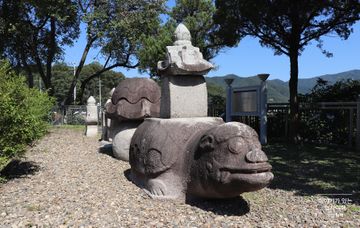익종 태봉 석조물
| 익종 태봉 석조물 Placenta Chamber of King Ikjong |
|
 김희태, 포천 태봉 석조물(포천시 향토유적 제30호) / 영중명 성동리에 자리한 효명세자(=추존 익종, 문조)의 태봉 석조물 / 제자리를 잃은 채 길가에 자리한 태봉 석조물의 안타까운 모습, 김희태의 ‘이야기가 있는 역사여행’, 네이버 블로그. |
|
| 대표명칭 | 익종 태봉 석조물 |
|---|---|
| 영문명칭 | Placenta Chamber of King Ikjong |
| 한자 | 翼宗 胎封 石造物 |
| 주소 | 경기도 포천시 영중면 성동리 640-1 |
| 지정(등록) 종목 | 포천시 향토유적 제30호 |
| 지정(등록)일 | 1986년 4월 9일 |
| 소유자 | 포천시 |
|
|
|
해설문
국문
익종(효명세자, 1809~1830)의 태(胎)를 묻은 곳이다.
익종은 조선 순조(1800~1834 재위)의 아들이며 헌종(1834∼1849 재위)의 아버지이다. 순조 12년(1812) 왕세자로 책봉되었으며, 순조 27년(1827)부터 왕을 대신하여 정사를 돌보았지만 4년 후에 향년 22세로 죽었다. 헌종이 즉위한 후 익종으로 추존하였다.
태실은 왕자·왕녀의 태를 묻은 무덤이다. 옛사람들은 태를 소중하게 여겨 좋은 땅에 묻으면 태의 주인이 지혜롭게 될 뿐만 아니라 병 없이 오래 살 수 있다고 믿었다. 특히 왕실에서는 높고 정결한 곳을 태를 묻기에 좋은 땅으로 여겨, 산봉우리 정상을 선택하였다.
이 태실은 일제강점기 전국의 태실이 훼손되는 과정에서 해체되었다. 남아 있던 연엽주석과 옹석 등 석조물은 한국전쟁 이후 당시 육군 제5군단에서 인수하여 보관하였다고 전해지며, 1977년 소공원이 조성될 때 이전하였다. 익종의 태실 조성 의식절차를 기록한 의궤 2건이 서울대학교 규장각한국학연구원에 소장되어 있다.
영문
Placenta Chamber of King Ikjong
This is the place where the placenta chamber of Crown Prince Hyomyeong (1809-1830) of the Joseon dynasty (1392-1910), known posthumously as King Ikjong, was buried.
A placenta chamber is where a nested jar containing a royal baby’s placenta and umbilical cord were enshrined. During the Joseon dynasty, a newborn baby’s placenta was regarded as the origin of life, and preserving it would ensure a healthy, advantageous life for the child. Because this was especially important to the royal family, they took great effort to find the most auspicious place and time to build a placenta chamber. It was often buried on a mountain peak, which then came to be known as Taebong, meaning “placenta peak.” This ritual of placenta chamber construction is unique to Korea.
Crown Prince Hyomyeong was the son of King Sunjo (r. 1800-1834). He became the crown prince in 1812 and governed on behalf of his father beginning in 1827. However, he died just three years later at the young age of 20 before he could become king. When his son later ascended the throne as King Heonjong (r. 1834-1849), he posthumously bestowed his father the title King Ikjong.
This placenta chamber was destroyed during the Japanese colonial period (1910-1945) when the colonial government destroyed such chambers nationwide. The placenta jar was relocated, and the remaining stone monuments were taken and preserved by the Korean Army after the Korean War (1950-1953). They were moved to their current location in 1977. Historical records relating to the burial of the placenta chamber are kept at the Kyujanggak Institute for Korean Studies at Seoul National University.
- "출생일 1809년 9월 18일 / 사망일 1830년 6월 25일 (20세)"